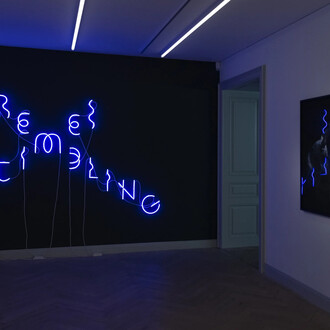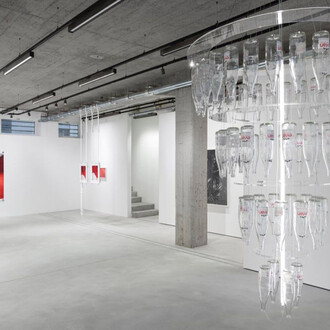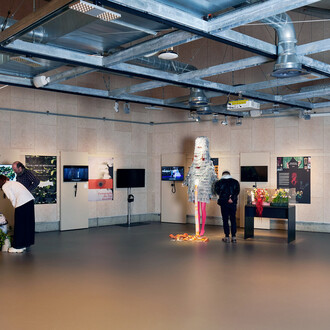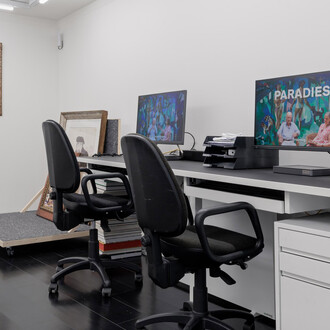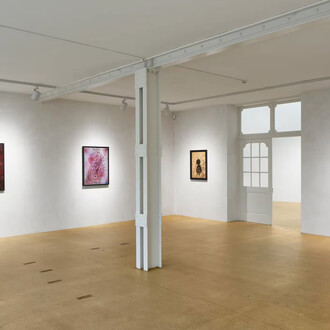On view in Zurich, Ed Clark. Paint is the subject is the first solo exhibition in Switzerland dedicated to this pioneering American abstractionist. Curated by Tanya Barson in close collaboration with the artist’s estate, the exhibition at our Limmatstrasse gallery brings together key works spanning seven decades, offering a comprehensive overview of the groundbreaking practice of Ed Clark.
The exhibition will feature a broad selection of his dynamic large-scale paintings and works on paper, as well as early works and an example of his use of the shaped canvas. The presentation will be complemented by archival photographs and documents that provide biographical and historical context, tracing the evolution of his innovative approach and lasting impact on modern painting.
Clark remained under-acknowledged for much of his career, but he received late recognition in his lifetime, a recognition that continues to grow. A member of the New York School, Ed Clark contributed towards redefining abstraction in the 1950s with two characteristic features—the deployment of the shaped canvas, and his unconventional use of a household broom to create sweeping, gestural compositions—the show’s title coming from a quote by the artist indicating the centrality of his medium to his work. Stylistically, his work bridges the physicality and spontaneity of Abstract Expressionism with the structured clarity of hard-edged abstraction, cementing his significance in postwar painting.
Born in New Orleans in 1926 and educated in Chicago and Paris, he travelled widely throughout his career, each location, its light and palette, impacting his work. Clark maintained close ties to Europe, living between New York and Paris from the 1960s onward. His aesthetic was shaped by the influence of European artists such as Nicolas de Staël and Pierre Soulages, while his artistic and intellectual circles included Joan Mitchell, Barbara Chase-Riboud, Beauford Delaney, Jack Whitten and James Baldwin, among others.
Ed Clark’s early work was figurative, exemplified in the Zurich exhibition by Standing woman at the chair (1949–50), before shifting toward abstraction in the early 1950s. During his time in Paris, he explored abstract form. His painting Untitled (1954) encapsulates this early period. Immersed in the French contemporary art scene, Clark came to believe that the true essence of painting lies not in realistic representation, but in the expressive application of paint, explored for its own sake: ‘I began to believe […] that the real truth is in the stroke. For me, it is large, bold strokes that do not refer distinctly to seen nature. The paint is the subject. The motions of the strokes give the work life. This began to enter into my paintings in a very personal way.’
Back in New York, Clark continued to innovate. In 1956, he began exploring shaped canvases and supports, which can be considered one of the earliest investigations within American abstract modernism, predating the shaped works of Frank Stella, Ellsworth Kelly, Al Loving and Sam Gilliam. He later experimented with oval canvases, first conceived during a stay at Joan Mitchell’s house in Vétheuil, France, in 1968. Works on view in Zurich such as Untitled (1970) and Silver stripes (1972) reflect this development, the ellipse motif and the oval support in his work aimed at expanding the field of vision, enhancing the immersive qualities of the canvas.
Clark’s use of the broom began in Paris and evolved significantly in New York. By the mid-1960s, he was laying his canvases on the floor and using large brooms to deliver sweeping horizontal strokes that captured speed and motion. His gestural language and ever greater emphasis on the brushstroke became central to his practice. A key highlight of the show is Untitled (Acrylic #1 from the series Louisiana) (1978), where Clark uses acrylics to capture the palette of the landscape of the Southern United States. Dividing the canvas into three sections—evoking earth, air, and water—he applied paint with broom, brush, and by hand, translating these environmental elements into abstract form. His choice of colors, ranging through pinks, blues, and beiges, deepens the specific sense of atmosphere evoking the landscape of his early childhood, and his return there to teach at Louisiana State University in the late 1970s.
As the 1980s progressed, Clark began exploring a new compositional approach he termed his tubular paintings, first seen in the series of Broken rainbow works. These supplanted the structures of narrow horizontal lines he employed in the previous decade, with curved strokes that introduced a suggestion of rotation as in Untitled (ca. 1990s). In later works such as Untitled (2002), Clark continues this exploration through broad, sweeping gestures and a looser, more fluid structure that became characteristic of his later style.
The Zurich exhibition provides a rare opportunity to experience the full scope of Clark’s practice, placing him in relation to diverse histories of abstraction and highlighting the enduring relevance of his work. It emphasizes how for Clark abstract art represented a greater truth than any realist depiction of the world and that for him ‘paint is the subject.’
Several works by Clark are also currently on view at the Centre Pompidou in Paris as part of the exhibition Paris noir: Artistic circulations and anti-colonial resistance, 1950 – 2000 at the Centre Pompidou (19 March – 30 June 2025), which explores the presence of black artists in France. His inclusion highlights the important African American diaspora working in Paris and the long-standing influence of Europe on his practice, situating his work within broader transatlantic narratives.









